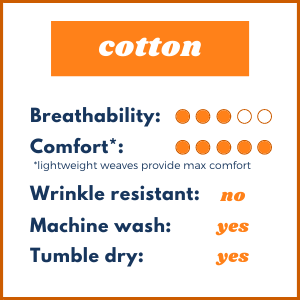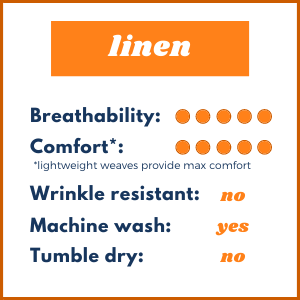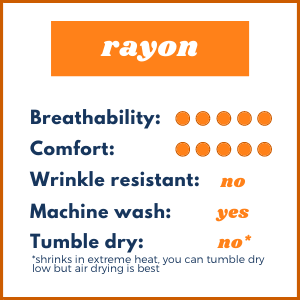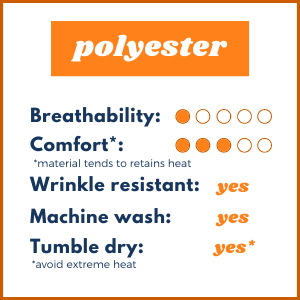Best fabrics for clothes
Our goal when we go traveling is to be comfortable and stick out as little as possible. That means that although we do have the classic hiking pant from our favorite outdoor store, we also want to look nice, and still comfortable, enough to survive what travel throws at ya. We are also minimalist packers, meaning we only travel with a carry-on sized roller (or equally sized backpack) and a daypack. So, the kinds of fabrics you pack when you only have TWO shirts, matters (ok, maybe we pack 3 shirts). In that spirit, today we are diving into commonly found fabrics so we can pick the best fabric, for the clothes of our next travel adventure.
Why fabric matters
Honestly it’s not so much fabric that matters, as it is style. If you are planning to only hike for your entire vacation, outdoor type stores will have everything you need, and then some. But, what if you trip is a mix of adventures? You will be hiking some, but you’ll also be fine dining?
As this over simplified Venn diagram shows you, your clothes must lie in the sweet spot between outdoor comfort, easy cleaning and pretty much everything else. The key component is choosing the right fabric! Many companies that offer ‘Athleisure’ wear (basically the love child of athletic and leisure clothes) tend to offer clothes that might get you into a fancy restaurant or a place with a dress code. Unfortunately, we’ve found them to be generally more expensive. Fear not! You can still find good quality, affordable clothes, that will serve both purposes, if you just know what fabric to look for.
Fabric types
There is basically 2 general categories for fabrics - natural fibers and man made fibers. In general, natural fibers are more eco-friendly because they bio-degrade more easily. On the other hand, man made fabrics are usually much cheaper and available in many more colors & styles.
Animal fibers
This category includes fabrics like sheep’s wool, alpaca wool, cashmere, angora, silk and feathers.
Wool is traditionally thought of as a cold weather fabric, but it can be spun very fine and made into items like t-shirts or lightweight pants. Wool is naturally antibacterial so you’ll be able to get more wears in between washes. However these knitted fabrics are not as easy to clean, often requiring laying the item flat to dry, so that it doesn’t deform. Fine wool clothes can also be pricey, but pricey is not always bad if you are planning to keep the item for a long time.
Silk fabric can also be very lightweight but it’s very delicate to clean, often requiring dry cleaning, therefore misses the Venn diagram for ideal travel fabric.
Feathers in this category generally refer to the filling, such as down jackets. This material is lightweight and insulates very well. The only downside (no pun intended) is that cleaning is not as easy as synthetic fillers.
Plant fibers
Like the name suggests these woven fabrics use fibers derived from plants. Although there are many types of plant fibers, the most common in the market are cotton and linen.
Cotton fabric gets a bad reputation because it does not dry quickly. The key to clothing made from cotton is to look for a light weave. The weave is how tightly the fibers are woven together; the lighter the weave, the quicker cotton will dry. Avoid thick edge or necks details.
Linen fabric is probably most famous for being extremely comfortable in hot weather. The only problem we found with linen was that it wrinkles like crazy! If you don’t mind this, or you are planning to travel somewhere you can iron (or have someone iron) your linen clothes, then this fabric is a winner. Although on the pricier side, linen is more eco-friendly than cotton because the flax plant used for this fabric can grow in poorer conditions and requires less water.
Natural Polymers
Despite the name natural in this category’s name, natural polymers are not so natural.
Rayon fabric can have many names such as viscose, tencel, modal and others. It is made from materials such as wood cellulose - basically wood gets ground to a pulp, put through a spinneret to produce filaments and then spun much like natural fibers would be. In general rayon is the most affordable and comfortable material for travel clothing. Like with natural fibers, look for light weaves so you don’t run into drying problems.
Synthetic Polymers
This category has perhaps the greatest dichotomy. These fabrics can be found on pretty much any type of apparel, from suits to dresses to workout clothes.
Polyester and Nylon fabrics are both resistant to shrinking, stretching and wrinkling; and quick drying too. Although they feel just a little bit different, Nylon being more stretchy in some cases, they behave very similarly. They both don’t breath well and tend to hold odor, if you know what we mean. However, they can be very popular options amongst people looking for fluid materials with great drape - aka, beautiful dress on Instagram, yep many are polyester.
Lastly, they are very affordable but unfortunately don’t bio-degrade well. Synthetic fibers have good uses but try to avoid having your whole travel wardrobe in the same type of fabric.
Sustainability
Clothing sustainability in the fashion industry is a huge topic that probably deserves a blog post of its own, if not many. We won’t attempt to digest it all as the focus of this post is comfort while traveling, but if you stick to natural fibers you’ll generally also be making the more eco-friendly choice. In general natural fibers are easier to dye with natural methods (less toxic waste from the dying process) and they will bio-degrade more easily. Natural is not always animal friendly so if that’s a concern, pick fabrics made from plant fibers.
That’s all we have for today - do you have questions? or have you found a favorite fabric we didn’t cover on this post? leave a comment below, we’d love to hear from ya!















